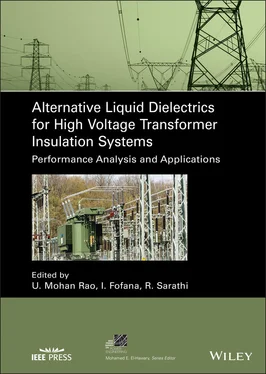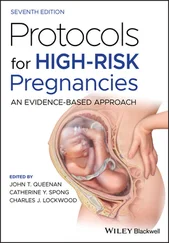1 ...8 9 10 12 13 14 ...22 The crude oil, when extracted from the seeds, is highly acidic and viscous in nature. The acidic nature and viscosity can be reduced by following the transesterification process of the NEOs [1, 2]. However, the transesterification process reduces the flash point of the NEO. To overcome the reduction in flash points, the NEO is blended with its transesterification‐processed oil. The blended oil has low viscosity, higher flash point, and higher impulse breakdown voltage (BDV) [2]. The proper blending of NEOs with MO can also be done for lowering the pour point at the same biodegradability [10].
A typical fatty acid composition of few NEOs is tabulated in Table 2.1. The unsaturated fatty acids are at risk of oxidation. Thus, the oxidation stability is lower for NEOs as compared with MO. Though these unsaturated fatty acids help in absorbing the gases released, the oxidation stability needs to be addressed. Another major drawback of the NEOs is the high values of pour point. The high pour points and high viscosity of VO are due to the presence of the fatty acids [14]. The viscosity, however, decreases to a certain extent with increase in temperature in a running transformer. The problem of high pour point and low oxidation stability can be dealt by using additives. Some of the additives used as antioxidants are tert‐butyl hydroxy quinone (TBHQ) and butylated hydroxytoulene (BHT). One of the additives used to lower the pour point is polyalkyl methacrylate [8]. The other disadvantage of the NEO is poor dissipation factor. NEOs are proven to be useful only in high‐voltage transformers and capacitors [1, 15]. The NEOs may be best utilized in power network with transformers in the coastal areas, where the oil spillage may result in serious threat to coral life and the aquatic life.
The different kinds of studies like electrical, chemical, and physical analyses of the oil are performed to estimate the life of the insulation. The aging study of oil can give information on the cellulose aging, low‐level partial discharge (PD), contamination, static electrification, circulating currents, and faults in the transformer. Aging and degradation studies are conducted to assess the gases, furans, phenols, cresols, and metal particles that are formed in the oil during the life of the insulation [11]. The acidity in MO increases with oxidation, whereas the acid generation in NEOs is dominated by the hydrolysis phenomenon. The NEOs are preferred to be used in sealed transformers due to the drawbacks of oxidation and hydrolysis [16]. It is also observed that the paper insulation immersed in NEOs have longer life than the paper immersed in MO [15]. The degree of polymerization (DP) of paper is lower for MO immersed paper insulation with aging compared with NEO immersed paper insulation. This is due to the higher moisture retention capability of the NEO [17]. The BDV is also observed to be higher in NEOs as compared with the MO.
Table 2.1 Typical fatty acid composition of some vegetable oils.
Source: Based on Beltrán et al. [8]; Oommen [11]; Dung and Huong [12]; Kumar et al. [13].
| Vegetable oil |
Saturated fatty acids (%) |
Unsaturated fatty acids (%) |
| Mono‐ |
Di‐ |
Tri‐ |
| Rapeseed/Canola oil a |
7.9 |
55.9 |
22.1 |
11.1 |
| Corn oil |
12.7 |
24.2 |
58 |
0.7 |
| Cottonseed oil |
25.8 |
17.8 |
51.8 |
0.2 |
| Peanut oil |
13.6 |
17.8 |
51.8 |
0.2 |
| Olive oil |
13.2 |
73.3 |
7.9 |
0.6 |
| Safflower oil |
8.5 |
12.1 |
74.1 |
0.4 |
| Safflower oil, high oleic |
6.1 |
75.3 |
14.2 |
— |
| Soybean oil |
14.2 |
22.5 |
51 |
6.8 |
| Sunflower oil |
10.5 |
19.6 |
65.7 |
— |
| Sunflower oil, high oleic |
9.2 |
80.8 |
8.4 |
0.2 |
| Jatropha Curcas oil |
19.1 |
46 |
34.9 |
| Rice oil |
12.4 |
15.9 |
71.7 |
| Pongamia oil |
13.76 |
60 |
23 |
| Neem oil |
40 |
20.9 |
39.1 |
| Mustard oil |
12.9 |
64.5 |
22.6 |
| Punna oil |
39 |
58.9 |
2.1 |
| Castor oil |
1.1 |
97.8 |
1.1 |
aLow erucic acid variety of rapeseed oil; more recently canola oil containing over 75% monounsaturate content has been developed.
The bubble inception temperature in the insulating oil is dependent on the moisture content of the paper insulation. As the moisture content of paper increases, the bubble inception temperature decreases. The bubble inception temperature also depends on the type of paper (kraft paper/thermally upgraded paper), gas content in oil, age of oil, rate of temperature rise, apart from the moisture content [18]. Any air bubble entrapped due to higher viscosity of the NEOs may reduce the impulse BDV of the NEO [19].
The NEOs are thermally more stable than the MO and the dissolved gas content is higher in the MO. The heat transfer characteristics of the oils can be improved by adding the nanoparticles (NPs). The NPs also help in increasing the BDV of the oils because of the electron‐scavenging nature. As the NEOs have already enhanced BDV as compared with MO, their BDV increases further with the stable dispersion of the NPs [4, 14, 20]. The moisture equilibrium is also an important factor when considering the use of NEOs for power applications. It is the balance between the amount of moisture quantity in paper and the moisture quantity in the oil and is temperature dependent. The shape variation of moisture equilibrium curve for paper–NEO is similar to the paper–MO while the moisture content in NEO is considerably higher than that of MO for same moisture content of paper [21]. The NEOs mostly comprise of triglycerides, and these triglycerides convert to long chain fatty acids on water ingression from paper to oil. These long chain fatty acids in the presence of cellulose, main composition of solid insulation, get transesterified. This leads to the lower moisture levels in the transformer, and thereby the degradation of insulation is slower. Another explanation for the lower degradation is the formation of the gel around the solid insulation, which avoids further degradation of the solid insulation [3, 5]. But if such gel formation happens, it reduces the thermal conductivity in the transformer and the hotspot temperature increases leading to winding damage.
The NEOs are reported to have higher breakdown strengths compared with the conventional MO. The stopping length of the streamers propagating in NEOs is known to be longer than that of streamers in MO when compared at the same value of testing voltage. The pre‐breakdown phenomenon in NEO needs to be studied extensively for condition monitoring and maintenance of the transformer liquid insulation. Pongamia oil methyl ester (POME) derived from karanji seeds is produced by transesterification of crude karanji seed extract and the POME shows enhanced properties when compared with MO on oxidative aging [16]. However, interfacial tension (IFT) and pour point are not superior for POME when compared with MO.
Dissolved gas analysis (DGA) is an important tool in diagnosis of oil‐filled transformers. The main objectives of DGA is to monitor the condition of equipment, operating conditions, and possible localization of faults [22, 23]. For low energy faults, same ratio of hydrogen and acetylene are released for NEO and MO, whereas for the low thermal faults, ethane is the main constituent [22]. The DGA response is the same in NEOs and MOs, but the percentage or gas ratios needs to be redefined because the rate of gas generation is lower for NEOs, which means the NEO is thermally more stable than MO [23, 24]. Stray gassing is observed in FR3 fluid at temperatures between 40 and 50 °C [25]. The use of antioxidants decelerates the aging of NEOs and kraft paper [12].
Читать дальше












